-

新人教版高中英语必修2Unit 4 History and Traditions-Discovering Useful Structure教案二
This teaching period mainly deals with grammar: The past participle is used as attributive and objective complement.1. Guide students to review the basic usages of the past participle used as attributive and objective complement.2. Lead students to learn to use some special cases concerning the past participle used as attributive and objective complement flexibly.3. Strengthen students’ great interest in grammar learning.1. Help students to appreciate the function of the past participle used as attributive and objective complement.2. Instruct students to write essays using the past participle used as attributive and objective complement.Step1:温故而知新。Analyze the underlined phrases and then sum up the common usages of the past participles.1.(教材P41)They had castles built(build) all around England, and made changes to the legal system.2.(教材P42)They use the same flag, known(know) as the Union Jack,...3.(教材P42)Judy and I had our car parked(park) in an underground car park near Trafalgar Square, where we could get our car battery charged(charge).Common points: f the past participle used as attributive and objective complement.Step 2:过去分词作定语时的意义1.及物动词的过去分词作定语,在语态上表示被动;在时间上,常表示动作已经发生或完成,有时也不表示时间性。Our teacher watched us doing the experiment and gave us a satisfied smile at last.我们的老师看着我们做实验,最后给了我们一个满意的微笑。The plan put forward at the meeting will be carried out soon.会上提出的计划将很快被执行。2.不及物动词的过去分词作定语,它不表示被动意义,只强调动作完成。Many little kids like gathering fallen leaves in the yard.

新人教版高中英语必修2Unit 4 History and Traditions-Reading and Thinking教案二
Step 5 While reading---Task 3Read the text again and answer the following questions.Q1: How many countries does the UK consist of ?4 Q2: What are the four countries of the United Kingdom?England, Wales, Scotland and Northern Ireland Q3: Which two were the first to be joined together ?England and WalesQ4: What are the two chief advantages of studying the history of a country ?The first one is to help you understand more about the country and its traditions.The second one is to make visiting it more enjoyable.Q5: What’s the author’s attitude towards studying the history ?Supportive/positiveStep 6 Post reading---Retell the textThe United Kingdom, Great Britain, Britain, England—many people are confused by (1)_____ these different names mean. In the 16th century, the nearby country of Wales (2) __________(join) to the Kingdom of England. In the 19 th century, the Kingdom of Ireland was added to create the United Kingdom of Great Britain and Ireland. Finally, the southern part of Ireland (3) ______ (break) away from the UK, which resulted in the full name we have today. However, most people just use the (4)_________(shorten) name: the UK. The four countries (5)__________ belong to the United Kingdom work together in some areas. There were four sets of invaders and the last group were the Normans. They had castles (6)_________(build) all around England and made changes (7)__________ the legal system. Studying the history of the country will make your visit much more (8)_________(enjoy). The capital city London is (9)___ ancient port city that has a history (10)______(date) back to Roman times. 1. what 2.was joined 3.broke 4.shortened 5.that 6. built 7.to 8.enjoyable 9.an 10.dating Step 6 Homework

新人教版高中英语必修2Unit 4 History and Traditions-Listening&Speaking&Talking教案二
Listening and Speaking introduces the topic of “Take part in a youth project”. The listening text is an interview about "sharing views on historical sites". Through listening to a dialogue between Chinese and foreign students on the way to the Confucius Temple, students can understand their views on the Confucius Temple, Confucius, Confucius' descendants and Confucius' educational thoughts, so as to realize and think about the profound influence of Confucius and his thoughts on Chinese historical tradition. At the same time, the dialogue naturally integrates English idioms and mentions Shakespeare, the British playwright, so as to provide language materials and context for students to understand English idioms and related cultural allusions, as well as to compare Chinese and foreign cultures, which is helpful for students to understand and express the language such as history, tradition, culture and custom significant impact.Text analysis: listening text is a dialogue between a British student and a Chinese student when he goes to the Confucius Temple. When William, a British student, visited the Confucius Temple, he asked Xiao Kong, a Chinese student, for directions. Xiao Kong was just going to the Confucius Temple to meet with the members of the research group, so they went together and exchanged their views on the Confucius Temple, Confucius, Confucius' descendants and Confucius' educational thoughts. From the perspective of foreign tourists, this paper describes their thoughts on Confucius, the great son of Confucius, who had a profound impact on Chinese history and cultural tradition, and his education.Listening and Talking introduces a visit to a historic tourist destination. Tourism is a common way to understand a country's history, culture, and customs and so on. Students listen to the dialogue between Xiao Yan, a youth hostel Usher, and Paul, a backpacker, to learn about Pingyao's famous historical and cultural attractions and Paul's travel experience and experience as a foreign tourist.

新人教版高中英语必修2Unit 5 Music-Discovering Useful Structures教案二
4. When he got absorbed in his world of music, he felt as if he could “see” the beauty of the world around him, like he had in his previous life.P·P as adverbial: _________________________________________________________________.Function: _______________________________________________________________________.Step 5 Solid Complete the passage with the words in brackets in their correct forms.Well known as a successful band, the Impact members show quite a few striking qualities. They never ever give up. When _____________(question) by the media, they are not _____________(discourage) and practise even harder. They are improving themselves by attending several master training class. They are united. _____________(fill with) team spirit, they act as a whole, always aiming for glory. Step 6 Difference and similarity from -ingObserve the following examples.1. He went out, shutting the door behind him.=He went out, ________________________________________________________.2. Not knowing what to do, he went to his parents for help.=__________________________________________, he went to his parents for help.Similarity: _______________________________________________________________________________________________________________________________________________________.Difference : _______________________________________________________________________________________________________________________________________________________.Step Practice1. ________ in a hurry, this article was not so good. 因为写得匆忙, 这篇文章不是很好。2. ________ carefully, he found something he hadn’t known before. 他仔细读书时, 发现了一些从前不知道的东西。3. ________ why he did it, the monitor said it was his duty. 当被问及他为什么要这么做时, 班长说这是他的职责

新人教版高中英语必修2Unit 5 Music-Reading and Thinking教案二
1. Get basic information about Eric; read deeply to understand the history and development of the virtual choir.2. Understand what the function of the virtual choir is and how to make a virtual choir.3. Understand the meaning of some languages in the context of the text through question guidance, such as “Many people do not have close friends or contacts who have the same interest in music.” and so on.Step 1 Leading-in1. Answer the following questions.Q1:Do you know the Apps like Tik Tok and Quick Hand?Q2: Do you want to make a Tik Tok video or a Quick Hand video?2. Play a Tik Tok video Step 2: Understanding the title Q1:What does the title mean ?Q2: Is the article a narration or exposition? Why? Q3: Can you change the title ? If you can, what is the title?Step 3: Scanning the whole text and getting the basic information1. Answer the following questions.Q1:Who came up with the idea for a virtual choir?Q2: Where did Eric studied the musical composition?Q3: What is his song?2. Find the main idea of each paragraph3. Deal with some new words.Step 4: Reading carefully to get detailed informationPara 1 How to make a virtual choir1. PreparationA. tools: a virtual camera; an Internet connectionB. hero/heroin: friends or some individuals who have the same interests2. Process

新人教版高中英语必修2Unit 5 Music-Reading for Writing教案二
The Internet celebrity Gao Yifeng. Years ago, he owned 5 companies and the staffs over 1,000, but during the economy crisis, he became nothing but debt. He was so worried that his hair became white overnight. There was a time when he wanted to killed himself. But after listening to the song Start Over by Liu Huan, he decided to cheer himself up. He started a steamed bun shop and gradually became a national chain shops. Now he became successful again.Walter Haddon said, “Music is the medicine of a troubled mind.” Music contains such a pleasant and inspiring force. Music gave him courage and bravery. When he listened to the song, it made his spirit fly like a kite in the wind. Music gave him strength and brought him relief. It was the rock I leant on to become strong and to get through those hard times. I hope none of us have to go through the same kind of suffering that he did. At the same time, we all go through various periods when we feel sad or alone. During those times, music can help us in the same way that it helped him. I hope we all will somehow begin to treasure music and make it a part of our life. Thank you for your listening !5.Revise your writing each other.Does he/she explain how music has changed his/her/someone else’s life?Are some of the rhetorical devices included and used properly ?Does he/she talk about how music makes him/her/someone feel?Is the first word in each sentences capitalised?Does he/she use correct punctuation ?

新人教版高中英语必修3Unit 1 Festivals and Celebrations教学设计二
1. Ss look at the picture and scan the passage to understand the main idea while teacher is giving the following questions to inspire Ss to think.*Where are those people?*What are they doing?*Why are they so excited?2. Ss complete the passage with the appropriate -ing form. Then discuss and check the answers with class.Answers: boring, interesting, taking, exciting, amazing3. The teacher raises questions for the students to discuss and encourages them to express their opinions.*Do you like La Tomatina? Why or why not?4. Each group representative reports the discussion result, the teacher gives feedback and the evaluation.Step 6 PracticeActivity 41. Ss complete the Ex 2 in Using structures.2. Check the answers after finishing the exercises.①The dragon boat races are the most exciting part of the Dragon Boat Festival.② The children were excited to go Easter egg hunting.③What an amazing performance! This is the best music festival I have ever been to.④We were amazed by her funny-looking hat.⑤His inspiring speech at the conference won the admiration/ favour of the audience.⑥This is a challenging game to test your memory and observation capabilities. 3. T asks Ss to finish Ex 3 and 4 in Using structures by themselves, then check the answers with class.Step 6 Homework1. Understand and master the functions and usage of the -ing form;2. Finish the other exercises in Using structures.1、通过本节内容学习,学生是否理解和掌握动词-ing形式作定语和表语的功能和意义;2、通过本节内容学习,学生能否在理解文段内容的基础上,根据上下文语境和表达逻辑,能正确运用动词-ing形式描述节日庆典。3、通过本节内容学习,学生是否归纳和积累用于表达情绪的相关词汇。

新人教版高中英语必修3Unit 2 Morals and Virtues教学设计二
Activity 41. Students complete the task of activity 4, then teachers and students check the answers. 2. The teacher organized the students to work together and asked them to use the tables and mind maps sorted out before to retold the important choices in Lin Qiaozhi's life and their resultsStep 5 Language points1. The teacher asks the students to read the text carefully, find out the core words and long and difficult sentences in the text and draw lines, understand the use of vocabulary, and analyze the structure of long and difficult sentences. 2. The teacher explains and summarizes the usage of core vocabulary and asks the students to take notes. 3. The teacher analyzes and explains the long and difficult sentences that the students don't understand, so that the students can understand them better. Step 6 Homework1. Read the text again, in-depth understanding of the text; 2. Master the use of core vocabulary and understand the long and difficult sentences. 3. Complete relevant exercises in the guide plan. 1、通过本节内容学习,学生是否理解和掌握阅读文本中的新词汇的意义与用法;2、通过本节内容学习,学生能否结合文本特点总结林巧稚的人生原则和人格品质特征;3、通过本节内容学习,学生能否针对人生抉择发表自己的看法;能否全面地、客观地、理性地看待问题,进而对道德和人性有更加深入的思考和理解。

新人教版高中英语必修3Unit 3 Diverse Cultures教学设计二
(2)Consolidate key vocabulary.Ask the students to complete the exercises of activity 6 by themselves. Then ask them to check the answers with their partners.(The first language:Damage of the 1906 San Francisco earthquake and fire.A second language: Yunnan - one of the most diverse provinces in China).Step 5 Language points1. The teacher asks the students to read the text carefully, find out the more words and long and difficult sentences in the text and draw lines, understand the use of vocabulary, and analyze the structure of long and difficult sentences.2. The teacher explains and summarizes the usage of core vocabulary and asks the students to take notes.3. The teacher analyzes and explains the long and difficult sentences that the students don't understand, so that the students can understand them better.Step 6 Homework1. Read the text again, in-depth understanding of the text;2. Master the use of core vocabulary and understand the long and difficult sentences.3. Complete relevant exercises in the guide plan.1、通过本节内容学习,学生是否理解和掌握阅读文本中的新词汇的意义与用法;2、通过本节内容学习,学生能否结合文本特点了解文章的结构和作者的写作逻辑;3、通过本节内容学习,学生能否了解旧金山的城市风貌、文化特色,以及加利福尼亚州的历史,体会多元文化对美国的影响。
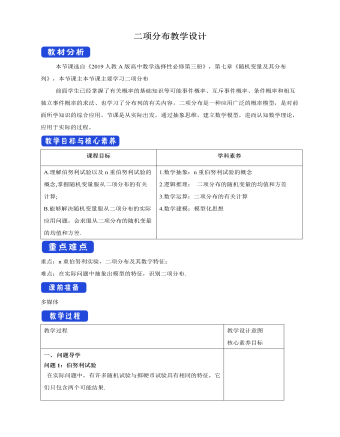
人教版高中数学选修3二项式定理教学设计
二项式定理形式上的特点(1)二项展开式有n+1项,而不是n项.(2)二项式系数都是C_n^k(k=0,1,2,…,n),它与二项展开式中某一项的系数不一定相等.(3)二项展开式中的二项式系数的和等于2n,即C_n^0+C_n^1+C_n^2+…+C_n^n=2n.(4)在排列方式上,按照字母a的降幂排列,从第一项起,次数由n次逐项减少1次直到0次,同时字母b按升幂排列,次数由0次逐项增加1次直到n次.1.判断(正确的打“√”,错误的打“×”)(1)(a+b)n展开式中共有n项. ( )(2)在公式中,交换a,b的顺序对各项没有影响. ( )(3)Cknan-kbk是(a+b)n展开式中的第k项. ( )(4)(a-b)n与(a+b)n的二项式展开式的二项式系数相同. ( )[解析] (1)× 因为(a+b)n展开式中共有n+1项.(2)× 因为二项式的第k+1项Cknan-kbk和(b+a)n的展开式的第k+1项Cknbn-kak是不同的,其中的a,b是不能随便交换的.(3)× 因为Cknan-kbk是(a+b)n展开式中的第k+1项.(4)√ 因为(a-b)n与(a+b)n的二项式展开式的二项式系数都是Crn.[答案] (1)× (2)× (3)× (4)√
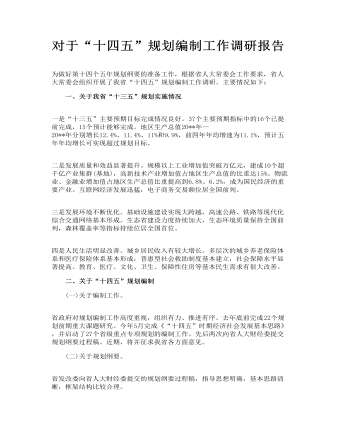
对于“十四五”规划编制工作调研报告
一是“十三五”主要预期目标完成情况良好。37个主要预期指标中的16个已提前完成,15个预计能够完成。地区生产总值20**年—20**年分别增长12.4%、11.4%、11%和9.9%,前四年年均增速为11.1%,预计五年年均增长可实现超过规划目标。 二是发展质量和效益显著提升。规模以上工业增加值突破万亿元,建成10个超千亿产业集群(基地),高新技术产业增加值占地区生产总值的比重达15%。物流业、金融业增加值占地区生产总值比重提高到6.8%、6.2%,成为国民经济的重要产业。互联网经济发展迅猛,电子商务交易额位居全国前列。
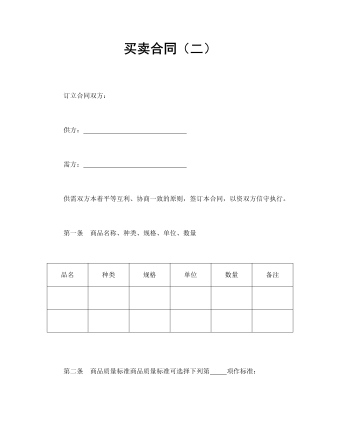
买卖合同(二)
订立合同双方:供方: 需方: 供需双方本着平等互利、协商一致的原则,签订本合同,以资双方信守执行。第一条 商品名称、种类、规格、单位、数量品名 种类 规格 单位 数量 备注第二条 商品质量标准商品质量标准可选择下列第 项作标准:1.附商品样本,作为合同附件。2.商品质量,按照 标准执行。(副品不得超过 %)。3.商品质量由双方议定。第三条 商品单价及合同总金额1.商品定价,供需双方同意按 定价执行。如因原料、材料、生产条件发生变化,需变动价格时,应经供需双方协商。否则,造成损失由违约方承担经济责任。2.单价和合同总金额: 。第四条 包装方式及包装品处理 。(按照各种商品的不同,规定各种包装方式、包装材料及规格。包装品以随货出售为原则;凡须退还对方的包装品,应按铁路规定,订明回空方法及时间,或另作规定。)
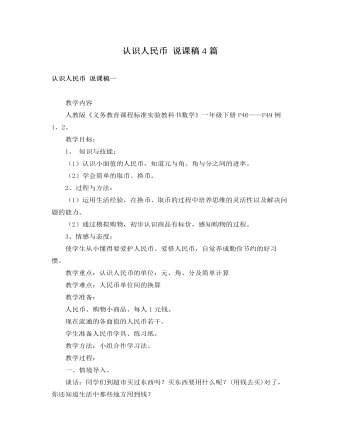
人教版新课标小学数学一年级下册认识人民币 说课稿4篇
一、说教材《认识人民币》是人教版小学数学一年级下册第五单元的第一课时的内容。本课是让学生认识各种面值的人民币,初步知道人民币的基本知识和如何使用人民币,提高社会实践能力;另一方面使学生加深对100以内数的概念的理解,体会数概念与现实生活的密切联系。二、说教学目标1、学生能够正确的认识各种面值的人民币,知道人民币的单位元、角、分,知道1元=10角。 2、能较熟练地辨认各种面值的人民币。 3、感受数学与实际生活的密切联系。。教学重点:认识各种面值的人民币,知道人民币的单位元、角、分,知道1元=10角。教学难点:人民币的等价兑换。三、说教法、学法在整个教学过程中采用小组合作交流的学习方式,为学生设计猜一猜,看钱、认钱,唱歌、分类等活动。
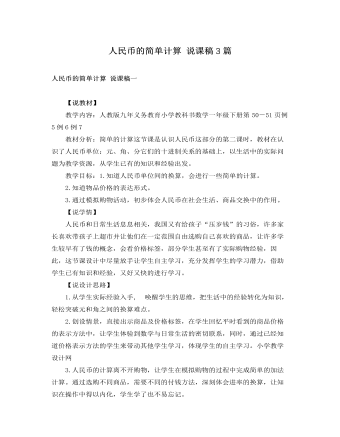
人教版新课标小学数学一年级下册人民币的简单计算 说课稿3篇
教学重难点:学会人民币单位间的换算和简单的加减法计算以及学会看物品价格的表示形式第三部分 设计意图1. 通过购物情景的创设,使课堂富有真实的生活气息。2. 为学生搭建知识的攀升阶梯,让学生经历数学知识的发展形成过程。3. 将所学知识应用现实生活中,解决实际问题。第四部分 教学过程一、创设情境,激趣导入。1.孩子们你们喜欢交朋友吗?(喜欢)在班级里谁是你的好朋友呀?(学生回答)你们喜欢我吗?我也想和你们做朋友。今天我还给同学们带来了一个新朋友?你们看它是谁?电脑出示米老鼠你们想和它做朋友吗?想和它做朋友上课就得好好表现,他们才愿意做你们的朋友.谁说一下,上课怎样做才是好好表现呢?(要专心听见,勇敢发言,)老师看看勇敢的你在哪里?
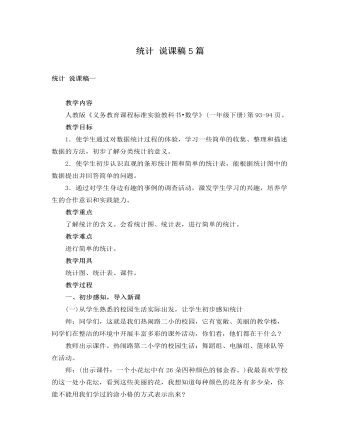
人教版新课标小学数学一年级下册统计 说课稿5篇
1.统计是数学课程标准规定的四个领域之一。传统上比较注重统计图表等知识和根据统计图表回答问题的教学,而课程标准则更加重视学生对数据统计过程的体验,学习一些简单的收集、整理和描述数据的方法,认识统计的作用和意义。这部分内容比较繁琐,分小组进行合作学习是有效的学习方式。2.教师将教科书的盆花变成纸花,努力为学生创设一些数据,使教材更具有实用性。但是,对于有条件的学校,可以带领学生进行实地统计,效果会更佳。3.教师要善于捕捉课堂上学生的反馈信息,创设轻松愉悦的课堂气氛。本课中,教师设计的让学生学四种动物的叫声,不仅活跃了课堂气氛,又引入到下一个问题的探讨。4.充分尊重学生的选择,让学生用自己喜欢的方法进行统计,使他们的情感、态度在其中得到了充分体验。
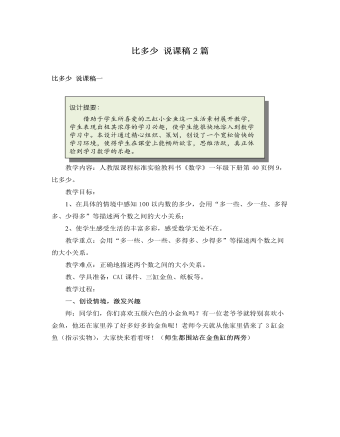
人教版新课标小学数学一年级下册比多少 说课稿2篇
五、总结与谈感受师:今天,我们学习了“比多少”(出示课题),同学们学会了用“多一些、少一些、多得多、少得多”来说明两个数之间的大小关系,还玩了猜数游戏,你们觉得这样的学习有趣吗?有什么感受呢?[总评]本课教学设计体现如下几个特点:1、 注重创设生活情境。从学生熟知的生活事例,感兴趣的事物(三缸小金鱼)引入,为学生提供了富有生活气息的具体情境。学生在具体情境中学习兴趣浓厚,积极性高涨,课堂气氛活跃,使学生以最佳的思维状态投入到学习中。2、注重体现学习方式。这节课学习过程,既注重培养学生独立思考的学习习惯,也注重培养学生合作交流的能力,不但学生个性思维方法得到了充分的展现,而且学生在合作交流中获取自己需要的信息,利于学生全面的发展。3、注重创设轻松课堂。猜数游戏的设计,创设了轻松愉快的课堂氛围,学生这样氛围中增长了知识,提高了能力,达到了寓教于乐的教学课堂境界,对学生学习数学兴趣产生不可量化的效果。

人教版新课标小学数学一年级下册摆一摆,想一想 说课稿3篇
2,解决三个圆片能摆出的数。小精灵聪聪也给大家提问题了:(课件出示:你能用三个圆片表示不同的数吗?)你们回答他,能不能?(1)现在请小朋友们自己动手摆一摆,并且不自己摆出来的数写在老师发给你们的纸上,看谁摆的又快又对。(2)汇报结果:你摆了几个数?分别是什么?是怎么摆的 ?这个活动的设计是为了培养学生的动手操作能力,提高学生学习数学的热情。利用自己总结出来的方法来进行操作,让学生体会到成就感。通过学生的汇报,培养学生的语言表达能力,让学生的手,脑,口的能力同时得到了锻炼。3,小朋友们真棒,现在我们不摆圆片,你能不能在脑子里想着摆圆片的方法,在纸上写出四个圆片都能表示那些数字呢 ?这个活动的设计,是让学生从操作走向有序的思维,让学生有条理的思考问题,将数学抽象化。
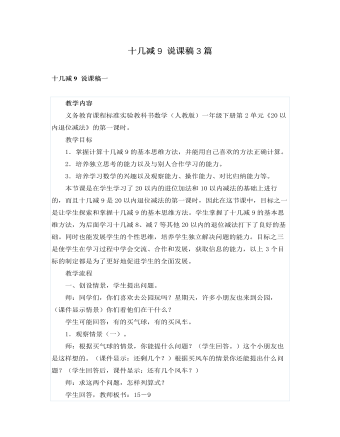
人教版新课标小学数学一年级下册十几减9 说课稿3篇
2.通过动手操作、交流算法,使学生经历十几减9的过程,知道想加算减、破十法、连减等多种计算方法,理解算理,掌握算法。能正确计算。3.在学习过程中,培养学生简单的推理能力、表达能力和解决问题的能力。教学重点:掌握十几减九的计算方法,正确、熟练的进行计算。教学难点:经历十几减九的过程,感受算法多样化,理解算理。我的教学过程分为四个大环节,其中第二环节是本节课的重点环节,我又设计了五个小层次:下面我就具体说一说我的教学过程。一、创设情境,复习导入(3分钟)我以元旦快到了,班里要举行游艺活动这样的情境进入练习。【设计意图:在带着学生走向新知之前,再现与新知有关的原认知,复习前面所学的20以内的进位加,数的分解和组成及10减几等知识,为今天学习新课做好铺垫。】接着我以元旦游艺活动,班里要用气球布置教室来引入新课。【设计意图:以学生感兴趣的身边问题吸引他们的注意力,激发兴趣,并巧妙引出新课。】
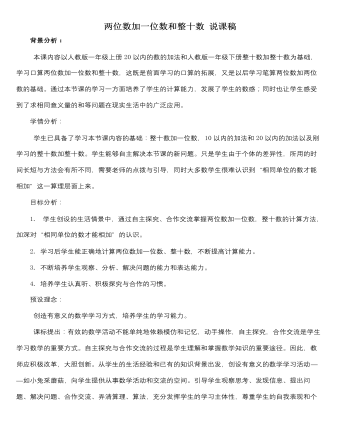
人教版新课标小学数学一年级下册两位数加一位数和整十数 说课稿
教材分析:本课内容是人教版一年级下册第六单元的第二课时“两位数加一位数和整十数”中的内容,包括两位数加一位数(不进位)、两位数加整十数;两位数加一位数(进位)。有两个例题,共用3节课完成。本节课是第一节,主要让学生理解算理,掌握算法。教材把加一位数与整十数对比集中编排,其目的是让学生加深对相同单位的数才能直接加减的算理认识,为后面学习两位数加减两位数打基础。教材的设计遵循了从具体到抽象的原则。先让学生在计算问题的情境中,动手操作、动脑想、讨论交流探讨不同的计算方法,再让学生运用获得的方法进行口算,体现了知识的形成过程,有利于培养学生抽象思维能力。练习设计注意专项与综合训练相结合,注意变换形式,突出正确率。这些都是我们教学中值得借鉴的。
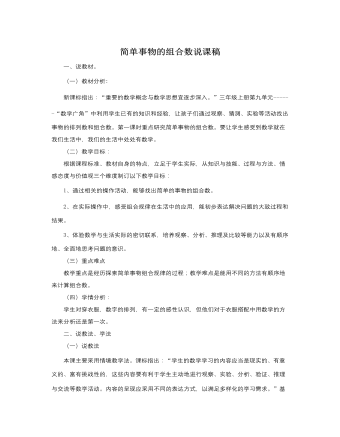
人教版新课标小学数学三年级下册简单事物的组合数说课稿
4、幸运碰撞文文选了一条近的路,然后顺利的来到了猴山。但是猴山的门被设置了密码,密码是由两位数组成,十位上是2、4、9这三个数中的任意一个,个位上是3、6、8三个数中的任意一个,文文最少几次,最多几次可以打开门呢?组织学生小组合作利用卡片拉一拉,并记录结果,全班交流。根据学生汇报,板书组合结果。5、拍照留念看到小朋友们玩得这么开心,聪聪和明明也来了。他们还带来了照相机,在这美好的时刻,新的问题又随之而来:四个小朋友每人都要和聪聪、明明单独各合一张影,一共要照多少张照片呢?孩子们可以在小组内扮演角色,记录不同的方法,还让学生当小摄影师,其余同学来评价。(三)汇报收获,拓展内化。请同学们回顾一下这节课都解决了哪些问题?怎样解决的?学生汇报完后,强调:在搭配中要做到既不重复又不遗漏就必须按一定的顺序进行观察、操作。在今后的学习生活中还会遇到许多这样的问题,鼓励学生只要发挥自己的聪明才智就一定能解决出来。

